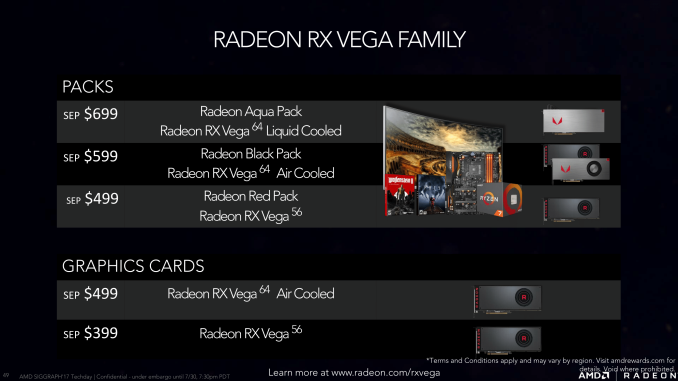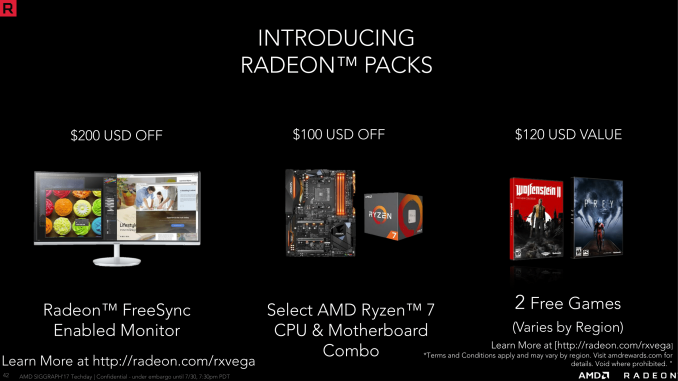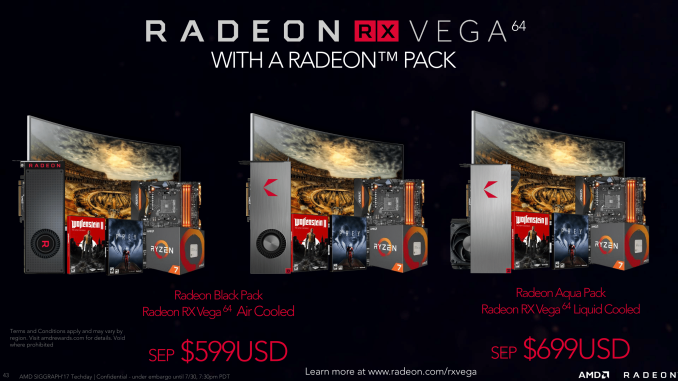Radeon RX Vega Unveiled: AMD Announces $499 RX Vega 64 & $399 RX Vega 56, Launching August 14th
by Ryan Smith on July 30, 2017 10:30 PM ESTBuying Radeon RX Vega: Prices & Bundles
Now that we’ve taken a look at the cards, let’s take a look at the prices. Card pricing and availability on RX Vega is not going to be very straightforward, so this requires a bit of focus.
First off, AMD will be offering RX Vega cards both with and without bundles. The latter point is going to be especially important, because these are no ordinary bundles. But if you just want a card – full stop – then AMD will be selling both the Vega 56 and Vega 64 stand-alone. These cards will go for $399 and $499 respectively. These prices, coincidentally enough, are relatively close to the prices of the GeForce GTX 1070 and GTX 1080, give or take some price fluctuations due to cryptocurrency mining demands.
As for AMD’s fancier Vega 64 Limited Edition and Vega 64 Liquid Cooled Edition card, these will not be available on a stand-alone basis at all. If you want these cards, they will only be available as part of a bundle.
However what’s not being said by AMD is how much of the RX Vega launch supply will be allocated to stand-alone cards. For various reasons the bundles are more lucrative to AMD and its partners, and as a result it’s difficult to imagine AMD sending the bulk of the cards to stand-alone configurations, or even a 50-50 split. Instead I expect that the bulk of the cards will go towards the bundles. So while we’re going to have to see what launch day brings next month, I’m not convinced that stand-alone cards will be available in great numbers.
Instead, if you want an RX Vega on launch day, and this is where things take an interesting turn. AMD has offered hardware bundles and game bundles before, but for their latest Radeon family, they have never offered a bundle quite like this.
For what amounts to a $100 premium, AMD is doing a combined software and hardware bundle. AMD calls these the Radeon Packs, and they include bundled games and hardware discounts. In short, if you commit to buying an RX Vega card for $100 more, you get access to AMD’s best cards with additional games and some sizable hardware discounts.
Overall the bundle contains the following items: an RX Vega video card, a $200 discount on Samsung’s CF791 34-inch WQHD Curved Freesync monitor, a $100 discount on a Ryzen 7 + motherboard bundle, and 2 AAA games (for North America this is Wolfenstein II and Prey, coming from AMD’s close partner Bethesda).
Bundle Contents
- AMD Radeon RX Vega Card
- 2 Bundled Games (For US: Wolfenstein II and Prey)
- $200 Discount: Samsung CF791 34-inch Widescreen Freesync Monitor
- $100 Discount: Ryzen 7 + Motherboard Combo
Perhaps the most important aspect of the deal is how the bundles work. Unlike traditional retailer bundles, these AMD bundles require purchasing the Radeon Pack version of the card. If you buy the stand-alone RX Vega cards, then you won’t get the games or qualify for the hardware discounts. And these Radeon Pack SKUs are, in turn, priced $100 over the stand-alone cards.
As for the contents of the bundle, the bundled games are rather straightforward: the bundle simply comes with the games (presumably in voucher form). For the hardware however, the discounts come in the form of an instant rebate on the hardware, not a voucher or other “bankable” form. This means that if you buy a Radeon Pack SKU, you must buy the discounted hardware at the same time to get the discount. You are not required to buy the hardware – instead paying the $100 premium just for the card selection and included games – but the discounts cannot be saved until later. It’s now or never.
All told then, the total cost to take full advantage of a Radeon Pack will not be cheap. The packs themselves are priced at $499 for the Vega 56 pack (Red Pack), $599 for a Vega 64 pack (Black Pack), or $699 for a Vega 64 Liquid Cooled Edition pack (Aqua Pack). Meanwhile, turning to our favorite retailer Newegg, the Samsung CF791 currently retails for $950, a Ryzen 7 1700X is $339, an a good X370 motherboard is $129 (or more). This would bring the total cost, after the $300 in rebates, to $1717. And this doesn’t account for external factors, such as which retailers are participating and whether they all price the most expensive component, the Samsung monitor, at the same $950 price.
The Rationale for Radeon Packs
Though unconventional, for AMD there is a reason behind these Radeon Packs. There are several, in fact.
First and foremost, AMD wants to sell gamers on a whole ecosystem, not just a single video card. They want to get gamers setup with a variable refresh monitor for smoother gaming, with the Samsung CF791 being a particularly popular (and large) monitor that’s a good fit for the expected performance of the RX Vega cards. Meanwhile as AMD is a GPU and CPU manufacturer, they of course want to get gamers buying both from them at the same time. It’s perhaps the strongest ecosystem play you can see a component vendor make, outside of a fully vertical company like Apple.
But more than that, the Radeon Packs are an attempt by AMD to “poison the well” for cryptocurrency miners, in order to ensure most RX Vega cards go to gamers. While we already have a basic idea of RX Vega’s mining performance via Vega FE, AMD seems genuinely concerned about miners scooping up RX Vega as well. So they want to prevent that from happening, and to assuage their gaming customers, they want to be seen as favoring gamers as well.
The bundles in turn are a shot at making RX Vega cards less palatable to miners by inflating their cost. All the miners need is a video card, so the extra $100 spent on the discounts they won’t use and the bundled games they won’t play just eats into the bottom line. For gamers on the other hand, hardware and software bundles have been a common fixture for years, and AMD believes that by bundling the cards with other things gamers would want, they can keep the cards desirable to gamers while making them less desirable to miners.
Even then it’s not a sure-thing for AMD. If RX Vega were to be especially awesome at mining, then miners could very well eat the cost of the card (this is how we got $900 R9 290s). Alternatively, for gamers who don’t need a new monitor or don’t want the games, then the bundles represent add-ins that inflate the cost of cards for them as well. So it will be very interesting to see how this plays out.
Otherwise the final factors – and things not said by AMD – are volume and pricing. If AMD only expects a limited number of cards to be on the market at the launch, then shifting most of the supply into the bundles is a chance to de facto charge more for the cards and make a bit more profit off of their sale. If they’re going to sell out anyhow, why not charge more?
At any rate, while the focus for the moment is on the August 14th launch of the RX Vega cards, the bundles will be a longer-term play for AMD than just the launch window. The company hasn’t set a definitive expiration window for the program, and we’ve been told to expect it to continue through at least the rest of the year. So depending on how things go, it’s entirely possible AMD could continue to offer the Radeon Packs well into the future if they’re successful.













162 Comments
View All Comments
tuxRoller - Monday, July 31, 2017 - link
It has poor mining efficiency? Presumably you're referring to the FE, correct?I wasn't aware of that.
Interesting.
That makes this so much worse.
vladx - Monday, July 31, 2017 - link
Pro drivers don't influence mining performance so RX Vega should have just as awful mining power/watt.CiccioB - Monday, July 31, 2017 - link
I would bet than the few dozens of AMD fans that have waited 14 months for getting a 1080 at double the power consumtion won't decrease nvidia's selling so that they need to lower its prices.lefty2 - Monday, July 31, 2017 - link
>what the heck are they waiting for at this pointThe drivers aren't ready. That's why Vega FE hadn't tile rendering enabled. I suspect that AMD's driver code base is a mess. Adapting it for GCN 5 was probably a massive task.
For the sounds of the announcement it doesn't seem that all features will be enabled even at launch.
lordken - Monday, July 31, 2017 - link
drivers are not ready? more than 8 months isn't enough? I'm kind of amd fan but wtf dude?its most likely more than 8months since they had chip ready - as they demoed it end of last year? Hell of a time for drive tuning...
Also drivers excuses is lame as Vega was mostly delayed due to HBM2, so if not for hbm delays it would be released without drivers at all or what?
meepstone - Sunday, July 30, 2017 - link
Generating hype always works. Keeps people interested. Like movie trailers that add extra scenes that get released months apart.ludicrousByte - Monday, July 31, 2017 - link
They should have done pre-orders, people always buy into that hype.mapesdhs - Wednesday, August 2, 2017 - link
Hmm, dunno, fair few people have been burned by the whole preorder thing, mostly re games but nevertheless a bitter aftertaste (eg. NMS).MrBlowfish - Monday, July 31, 2017 - link
Exactly.This great marketing worked out so well for AMD, that after X1950, HD4870, HD6870, R9 290, and RX 480 I went and bought a GTX1080, the first nVidia card since I retiered my 8600GT back in the days.
Awesome job there AMD. :D
at80eighty - Monday, July 31, 2017 - link
<i>This kind of dragged out release only pisses me off and cheer for them to implode</i>You sound like a mentally well adjusted individual